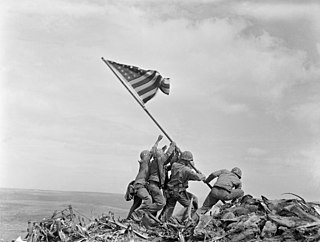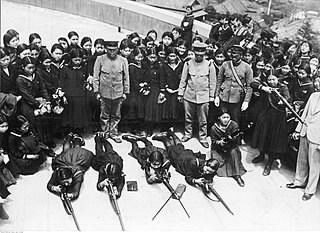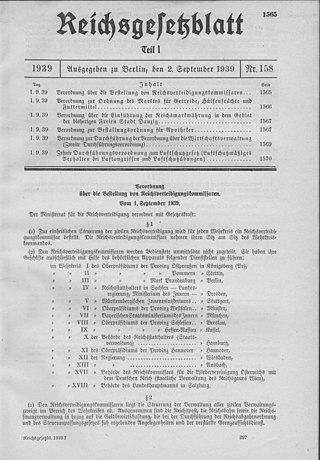
The Civilian Conservation Corps (CCC) was a voluntary government work relief program that ran from 1933 to 1942 in the United States for unemployed, unmarried men ages 18–25 and eventually expanded to ages 17–28. The CCC was a major part of President Franklin D. Roosevelt's New Deal that supplied manual labor jobs related to the conservation and development of natural resources in rural lands owned by federal, state, and local governments. The CCC was designed to supply jobs for young men and to relieve families who had difficulty finding jobs during the Great Depression in the United States. There was eventually a smaller counterpart program for unemployed women called the She-She-She Camps, which were championed by Eleanor Roosevelt.

Organisation Todt was a civil and military engineering organisation in Nazi Germany from 1933 to 1945, named for its founder, Fritz Todt, an engineer and senior member of the Nazi Party. The organisation was responsible for a huge range of engineering projects both in Nazi Germany and in occupied territories from France to the Soviet Union during the Second World War. The organisation became notorious for using forced labour. From 1943 until 1945 during the late phase of the Third Reich, OT administered all constructions of concentration camps to supply forced labour to industry.

The Pacific War, sometimes called the Asia–Pacific War, was the theater of World War II that was fought in eastern Asia, the Pacific Ocean, the Indian Ocean, and Oceania. It was geographically the largest theater of the war, including the vast Pacific Ocean theater, the South West Pacific theater, the Second Sino-Japanese War, and the Soviet–Japanese War.

Edward Granville Theodore was an Australian politician who served as Premier of Queensland from 1919 to 1925, as leader of the state Labor Party. He later entered federal politics, serving as Treasurer in the Scullin Labor government.

South West Pacific Area (SWPA) was the name given to the Allied supreme military command in the South West Pacific Theatre of World War II. It was one of four major Allied commands in the Pacific War. SWPA included the Philippines, Borneo, the Dutch East Indies, East Timor, Australia, the Territories of Papua and New Guinea, and the western part of the Solomon Islands. It primarily consisted of United States and Australian forces, although Dutch, Filipino, British and other Allied forces also served in the SWPA.

The "Brisbane Line" was a defence proposal supposedly formulated during World War II to concede the northern portion of the Australian continent in the event of an invasion by the Japanese. Although a plan to prioritise defence in the vital industrial regions between Brisbane and Melbourne in the event of invasion had been proposed in February 1942, it was rejected by Labor Prime Minister John Curtin and the Australian War Cabinet. An incomplete understanding of this proposal and other planned responses to invasion led Labor minister Eddie Ward to publicly allege that the previous government had planned to abandon most of northern Australia to the Japanese.

Volunteer Fighting Corps were armed civil defense units planned in 1945 in the Empire of Japan as a last desperate measure to defend the Japanese home islands against the projected Allied invasion during Operation Downfall in the final stages of World War II.

The history of Canada during World War II begins with the German invasion of Poland on 1 September 1939. While the Canadian Armed Forces were eventually active in nearly every theatre of war, most combat was centred in Italy, Northwestern Europe, and the North Atlantic. In all, some 1.1 million Canadians served in the Canadian Army, Royal Canadian Navy, Royal Canadian Air Force, out of a population that as of the 1941 Census had 11,506,655 people, and in forces across the empire, with approximately 42,000 killed and another 55,000 wounded. During the war, Canada was subject to direct attack in the Battle of the St. Lawrence, and in the shelling of a lighthouse at Estevan Point on Vancouver Island, British Columbia.

RAAF Base Townsville is a Royal Australian Air Force (RAAF) air base located in Garbutt, 2 nautical miles west of Townsville in Queensland, Australia. It is the headquarters for No. 1 Wing Australian Air Force Cadets and, along with Lavarack Barracks, establishes Townsville as a key military centre. The base's airfield is shared with the Townsville Airport.

Australia entered World War II on 3 September 1939, following the government's acceptance of the United Kingdom's declaration of war on Nazi Germany. Australia later entered into a state of war with other members of the Axis powers, including the Kingdom of Italy on 11 June 1940, and the Empire of Japan on 9 December 1941. By the end of the war, almost a million Australians had served in the armed forces, whose military units fought primarily in the European theatre, North African campaign, and the South West Pacific theatre. In addition, Australia came under direct attack for the first time in its post-colonial history. Its casualties from enemy action during the war were 27,073 killed and 23,477 wounded. Many more suffered from tropical disease, hunger, and harsh conditions in captivity; of the 21,467 Australian prisoners taken by the Japanese, only 14,000 survived.

Labour battalions have been a form of alternative service or unfree labour in various countries in lieu of or resembling regular military service. In some cases they were the result of some kind of discriminative segregation of the population, while in some others they have been a conscious choice.

The Allied leaders of World War II listed below comprise the important political and military figures who fought for or supported the Allies during World War II. Engaged in total war, they had to adapt to new types of modern warfare, on the military, psychological and economic fronts.

Although most Australian civilians lived far from the front line, the Australian home front during World War II played a significant role in the Allied victory and led to permanent changes to Australian society.

When the United Kingdom declared war on Nazi Germany in September 1939 at the start of World War II, it controlled to varying degrees numerous crown colonies, protectorates, and India. It also maintained unique political ties to four of the five independent Dominions—Australia, Canada, South Africa, and New Zealand—as co-members of the then "British Commonwealth". In 1939 the British Empire and the Commonwealth together comprised a global power, with direct or de facto political and economic control of 25% of the world's population, and of 30% of its land mass.

The Advisory War Council (AWC) was an Australian Government body during World War II. The AWC was established on 28 October 1940 to draw all the major political parties in the Parliament of Australia into the process of making decisions on Australia's war effort and was disbanded on 30 August 1945.

The Australian Army was the largest service in the Australian military during World War II. Prior to the outbreak of war the Australian Army was split into the small full-time Permanent Military Forces (PMF) and the larger part-time Militia. Following the outbreak of war on the 3rd of September 1939, 11 days later, on 14 September 1939 Prime Minister Robert Menzies announced that 40,000 members of the Militia would be called up for training and a 20,000-strong expeditionary force, designated the Second Australian Imperial Force, would be formed for overseas service. Meanwhile, conscription was introduced in October 1939 to keep the Militia at strength as its members volunteered for the AIF. The Australian Army subsequently made an important contribution to the Allied campaigns in the Mediterranean, the Middle East and North Africa fighting the Germans, Italians, and Vichy French during 1940 and 1941, and later in the jungles of the South West Pacific Area fighting the Japanese between late 1941 and 1945. Following the Japanese surrender Australian Army units were deployed as occupation forces across the South West Pacific. Meanwhile, the Army contributed troops to the British Commonwealth Occupation Force (BCOF) in Japan from 1946.

The Curtin government was the federal executive government of Australia led by Prime Minister John Curtin. It was made up of members of the Australian Labor Party in the Australian Parliament from 1941 to 1945.

Archerfield Second World War Igloos Complex is a heritage-listed group of hangars at 98-138 Kerry Road, Archerfield Airport, Archerfield, City of Brisbane, Queensland, Australia. They were built from February 1943 February to circa April 1944 by the Allied Works Council. They were also known as Hastings Deering (Australia) Ltd premises and Thiess Contractors Pty Ltd premises. They were added to the Queensland Heritage Register on 27 August 1999.

Australian women during World War II played a larger role than they had during World War I.

Reich Defense Commissioner was a governmental position created in Nazi Germany at the outbreak of World War II on 1 September 1939. Charged with overall defense of the territory of the German Reich, there was originally one Reich Defense Commissioner for each of 15 Wehrkreise. On 16 November 1942, the geographical scope was reduced to the Gau level, raising the number of Reich Defense Commissioners to 42.




















